#Error Code 1962
Explore tagged Tumblr posts
Text
mermaids

Katy Keene encountered mermaids in the 50s. No navel, the scales passed the stomach. Just as Betty's 1980 costume does. Just as the mermaid Archie encountered in 1962 does. And the one he encountered in 1973 (coloring error it may be). Disney affixed the mermaid image to one showing Ariel's navel. Also to red hair.

Okay. I hate to be crude, but. Which half fish / half woman would one want? I suppose this being the code approved world -- Reggie has it better. Otherwise -- ?

#Archie Comics#Archie Andrews#Betty Cooper#Veronica Lodge#Mermaid#Costume party#Reggie Mantle#Costume#Moose Mason#Midge Klump#Under the sea#Fish#Fishing#Dan Parent#2011#2013#Stan Goldberg#1990#1980#Jeff Shultz#2021#Bill Golliher#1991
8 notes
·
View notes
Text
CCS Customs Experts in India – Trusted Compliance & Clearance Professionals
Partner with CCS Customs Experts in India for reliable customs clearance, DGFT compliance, and end-to-end import-export support. Fast, accurate, and government-compliant logistics services.

CCS Customs Experts – Your Trusted Partner in Customs Compliance and Clearance
In today's fast-paced global trade environment, navigating international customs regulations can be complex and time-consuming. That's where CCS Customs Experts come in—offering specialized knowledge, timely execution, and reliable customs clearance solutions tailored to your business needs. As trade regulations evolve and cross-border compliance becomes more stringent, CCS Customs Experts help importers and exporters streamline operations, avoid delays, and stay fully compliant with all legal and procedural requirements.
What Does CCS Customs Experts Offer?
CCS (Customs Clearance Services) Customs Experts are professionals trained in handling all facets of customs brokerage and international trade documentation. They serve as an essential bridge between businesses and government customs authorities, ensuring smooth movement of goods through international borders.
Core services typically include:
Import and export customs clearance
HS code classification
Duty and tax calculation
Regulatory compliance consulting
Liaising with customs officials
Managing customs documentation (bill of entry, shipping bills, etc.)
DGFT (Directorate General of Foreign Trade) services
Handling bonded warehousing and re-export procedures

Why Choose CCS Customs Experts?
1. Expertise in Indian Customs Regulations Navigating India’s customs laws can be complicated due to multiple ministries and regulatory bodies involved. CCS Customs Experts are well-versed in the Indian Customs Act, 1962, and Foreign Trade Policy (FTP), ensuring every shipment complies with current norms and avoids penalties.
2. Speed and Accuracy Delays at customs can lead to demurrage charges, missed delivery deadlines, and disrupted supply chains. CCS professionals ensure faster processing by preparing complete, accurate documentation and proactively addressing potential red flags.
3. Industry-Specific Knowledge Whether you're in pharmaceuticals, electronics, automotive, FMCG, or textiles, CCS Customs Experts understand sector-specific import/export rules and can optimize duty benefits under schemes like MEIS, RoDTEP, SEZ, and EPCG.
4. End-to-End Support From the moment your shipment leaves the supplier to its final delivery destination, CCS experts manage customs documentation, compliance, logistics coordination, and real-time tracking, offering total peace of mind.
5. Digital & EDI Filing CCS Customs Experts leverage modern platforms like ICEGATE for Electronic Data Interchange (EDI) filing, ensuring error-free, timely submission of documents to Indian Customs.
Benefits of Working with CCS Customs Experts
Reduced Risk: Avoid misclassification, overpayment of duties, and compliance breaches.
Time Savings: Streamlined processes mean faster clearance and quicker delivery.
Cost Efficiency: Optimized duty structures and benefits from trade agreements lower logistics costs.
Reliable Consultation: Stay updated with the latest changes in trade policies and customs laws.
CCS Customs Experts in India
With the growing complexity of global trade and increased scrutiny at Indian ports, CCS Customs Experts in India play a vital role in the logistics ecosystem. They are especially crucial at major hubs like Nhava Sheva (JNPT), Mumbai Airport, Delhi ICD, Chennai Port, and Mundra—where high cargo volumes and strict regulations demand seasoned professionals.
#CCSCustomsExperts#CustomsClearanceIndia#CCSIndia#ImportExportCompliance#DGFTSupport#CustomsBrokerIndia#LogisticsExperts#TradeComplianceIndia#FreightForwardingIndia#CustomsSolutions#EXIMIndia#CCSCompliance#CustomsConsultants#IndianTradeSupport#CargoClearanceIndia#CHAExperts#InternationalTradeIndia#SupplyChainIndia#TradeFacilitationIndia#CustomsDocumentation
0 notes
Text
Typos
In 2013, Texans got the deal of a lifetime when a misprint in a Macy’s mailer advertised a $1500 necklace for just $47. (It should have read $497.) It didn’t take long for the entire inventory to be zapped, at a loss of $450 a pop to the retail giant.
In 2010, Harvard University researchers claimed that the company earned about $497 million each year from people mistyping the names of popular websites and landing on “typosquatter” sites … which just happen to be littered with Google ads.
The damage: $80 million
Hyphens don’t usually score high on the list of most important punctuation. But a single dash led to absolute failure for NASA in 1962 in the case of Mariner 1, America’s first interplanetary probe. The mission was simple: get up close and personal with close neighbour Venus. But a single missing hyphen in the coding used to set trajectory and speed caused the craft to explode just minutes after takeoff. Arthur C. Clarke, author of 2001: A Space Odyssey, called it “the most expensive hyphen in history.”
The damage: £300
Not even the heavenly father is immune to occasional inattention to detail. In 1631, London’s Baker Book House rewrote the 10 Commandments when a missing word in the seventh directive declared, “Thou shalt commit adultery.” Parliament was not singing hallelujah; they declared that all erroneous copies of the Good Book—which came to be known as “The Wicked Bible”—be destroyed and fined the London publisher £300, or more than £52,000 today.
The damage: $20,000
A plate of tagliatelle with sardines and prosciutto would typically only be offensive to a vegetarian’s senses. But an unfortunate blunder in The Pasta Bible, published by Penguin Australia in 2010, recommended seasoning the dish with “salt and freshly ground black people.” Though no recall was made of the books already in circulation, the printer quickly destroyed all 7000 remaining copies in its inventory.
The damage: $225 million
In December 2005, Japan’s Mizuho Securities introduced a new member to its portfolio of offerings, a recruitment company called J-Com Co., nicely priced at ¥610,000 per share. But one of the company’s traders made more than a simple boo-boo when he sold 610,000 shares at ¥1 apiece. No amount of pleading to the Tokyo Stock Exchange could reverse the error. It cost the company $225 million.
www.mentalfloss.com
1 note
·
View note
Text
Events 1.1 (between 1940-1990)
1942 – The Declaration by United Nations is signed by twenty-six nations. 1945 – World War II: The German Luftwaffe launches Operation Bodenplatte, a massive, but failed, attempt to knock out Allied air power in northern Europe in a single blow. 1947 – Cold War: The American and British occupation zones in Allied-occupied Germany, after World War II, merge to form the Bizone, which later (with the French zone) became part of West Germany. 1947 – The Canadian Citizenship Act 1946 comes into effect, converting British subjects into Canadian citizens.[64] Prime Minister William Lyon Mackenzie King becomes the first Canadian citizen. 1948 – The British railway network is nationalized to form British Railways. 1949 – United Nations cease-fire takes effect in Kashmir from one minute before midnight. War between India and Pakistan stops accordingly. 1956 – Sudan achieves independence from Egypt and the United Kingdom. 1957 – George Town, Penang, is made a city by a royal charter of Queen Elizabeth II of the United Kingdom. 1957 – Lèse majesté in Thailand is strengthened to include "insult" and changed to a crime against national security, after the Thai criminal code of 1956 went into effect.: 6, 18 1958 – The European Economic Community is established. 1959 – Cuban Revolution: Fulgencio Batista, dictator of Cuba, is overthrown by Fidel Castro's forces. 1960 – Cameroon achieves independence from France and the United Kingdom. 1962 – Western Samoa achieves independence from New Zealand; its name is changed to the Independent State of Western Samoa. 1964 – The Federation of Rhodesia and Nyasaland is divided into the independent republics of Zambia and Malawi, and the British-controlled Rhodesia. 1965 – The People's Democratic Party of Afghanistan is founded in Kabul, Afghanistan. 1970 – The defined beginning of Unix time, at 00:00:00. 1971 – Cigarette advertisements are banned on American television. 1973 – Denmark, Ireland and the United Kingdom are admitted into the European Economic Community. 1976 – A bomb explodes on board Middle East Airlines Flight 438 over Qaisumah, Saudi Arabia, killing all 81 people on board. 1978 – Air India Flight 855, a Boeing 747, crashes into the Arabian Sea off the coast of Bombay, India, due to instrument failure, spatial disorientation, and pilot error, killing all 213 people on board. 1979 – the Joint Communiqué on the Establishment of Diplomatic Relations and Taiwan Relations Act enter into force. Through the Communiqué, the United States establishes normal diplomatic relations with China. Through the Act, the United States guarantees military support for Taiwan. 1981 – Greece is admitted into the European Community. 1982 – Peruvian Javier Pérez de Cuéllar becomes the first Latin American to hold the title of Secretary-General of the United Nations. 1983 – The ARPANET officially changes to using TCP/IP, the Internet Protocol, effectively creating the Internet. 1984 – The original American Telephone & Telegraph Company is divested of its 22 Bell System companies as a result of the settlement of the 1974 United States Department of Justice antitrust suit against AT&T. 1984 – Brunei becomes independent of the United Kingdom. 1985 – The first British mobile phone call is made by Michael Harrison to his father Sir Ernest Harrison, chairman of Vodafone. 1987 – The Isleta Pueblo tribe elect Verna Williamson to be their first female governor. 1988 – The Evangelical Lutheran Church in America comes into existence, creating the largest Lutheran denomination in the United States. 1989 – The Montreal Protocol comes into force, stopping the use of chemicals contributing to ozone depletion. 1990 – David Dinkins is sworn in as New York City's first black mayor.
0 notes
Text
How to Troubleshoot “No Operating System Found” Error Code 1962?
If your computer system creates a problem in booting, don’t worry this is a ordinary issue in Windows 10 OS despite some other device models. Though, there is some frequent glitches that is associated with only Lenovo computers that is error code 1962. This error signifies that “No Operating System Found” which creates irritation among various Lenovo users. Usually, Windows 10 error code 1962 ‘No Operating System Found’ encounters by the Lenovo users at the time of boot, immediately after restarting the computer system. Recently, many Lenovo users have reported the error code 1962 and want to install as soon as possible.

Nevertheless, this type of rumors is somehow conflicting. If in case, Windows 10 1962 “No Operating System Found’ displayed after the installation of Windows 10 or its latest updates, but somewhat it is probably to be a twist of fate. When you ensure that the update or installation of Windows 10 is a reason behind the error, then we suggest you run the Windows analytics at boot or need to do a clean installation of that software. Mostly, the issue arises from either the damaged HDD or SATA cable which is directly attached to the good functioning motherboard and HDD. Therefore, to troubleshoot the error code 1962 ‘, No Operating System Found” you should need to follow some troubleshooting steps which helps you in resolving the error code 1962 without creating any hurdle. The steps are discussed below.
Steps to Troubleshoot “No Operating System Found” Error Code 1962?
Before proceeding further, remember that to avoid trouble you need to follow the steps in the sequence as mentioned below. Otherwise, the process is more difficult to follow and much time-consuming. Here how to fix it:
Solution-1: Type Computer’s BIOS
Long press Ctrl + Alt + Del tabs altogether.
After that, reboot your computer system.
In order to Change to BIOS, click on the F12 many times.
Now, a ‘Setup written box’ appears on the screen, click on the ‘Enter’ key.
Then, choose ‘Startup button located at the header of the screen and choose CSM option.
Choose and press the ‘Now choose the Turned On option’ tab.
Search for the ‘Boot Priority’ tab and tap on ‘Enter’ key.
Afterward, you need to modify the ‘Legacy First to the UEFI First’ tab.
Once modified, tap the F10 key on the keyboard and choose ‘Yes’ tab.
When completed, your computer system starts rebooting without the Windows 10 error code 1962 ‘No Operating System Found.’
Solution-2: Modify Boot Options
Firstly, long press the ‘Shift’ button on the keyboard and tap on the ‘Shut Down’ tab located at the boot menu of the screen at once.
Long click on the F2 tab and press the ‘Power’ tab. Do Not free the F2 tab till the BIOS screen emerges on the system screen.
When the BIOS launches on the screen, now easily free the F2 button and navigate to the Boot section.
In case, if you unable to boot into the Windows, you need to follow 1-3 instructions from the earlier solution.
Click to launch the ‘Boot ‘ section.
Now, you need to verify the Priority list, if boot drive is not yet scheduled at the top of the screen.
Here you need to shift the boot drive instead of the Windows Boot Manager, DVD Rom or USB HDD.
Click on the ‘Save’ tab to save all the changes and exit all the BIOS option.
Once completed, restart your computer system to save all the changes.
Lucia Mandela is a Microsoft Office expert and has been working in the technical industry since 2002. As a technical expert, Lucia has written technical blogs, manuals, white papers, and reviews for many websites such as office.com/setup.
Source: Error Code 1962
4 notes
·
View notes
Photo

How to Troubleshoot “No Operating System Found” Error Code 1962? If your computer system creates a problem in booting, don’t worry this is a ordinary issue in Windows 10 OS despite some other device models.
0 notes
Video
youtube
Johnny Ramensky, the Scottish safe cracker was born on April 6th 1905 in Glenboig, Lanarkshire.
This is the type of story that would make a great film, so settle down to enjoy the life of the man born Jonas Ramanauckas, who became known as John Ramsay, Gentleman Johnny, and Gentle Johnny
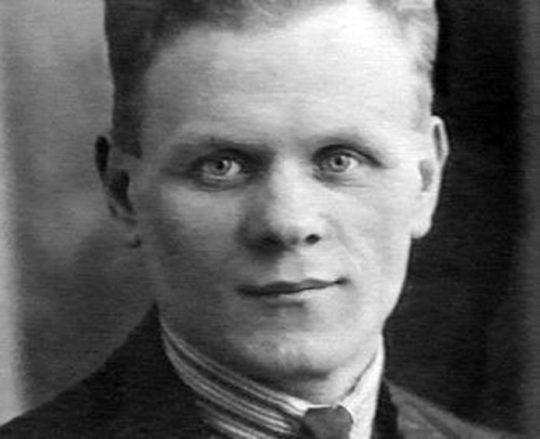
His father was a miner who died when Johnny was young and the young Ramensky also became a miner. It was while he was down the pit that he learned his skills with dynamite which were to prove so useful to him in later years.
Johnny drifted in and out of trouble from the age of eleven and moved to the Gorbals area of Glasgow during the Depression with his mother and two sisters. He developed an amazing physical strength and acrobatic ability but in order to obtain some money, he became a burglar, specializing in robberies involving climbing up external rone-pipes to gain entry to premises. He also developed skills in picking locks and safe-cracking with explosives.
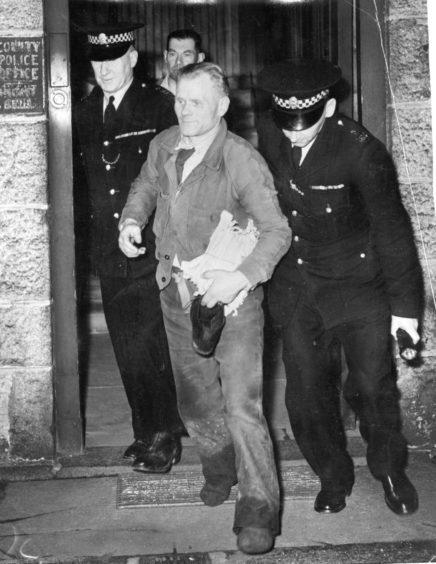
While his activities were criminal, he had his own code of conduct and raided business premises rather than people's homes. And when he was caught, he never resisted arrest. His philosophy seemed to be "if you are caught, you are caught - it's all part of the job".
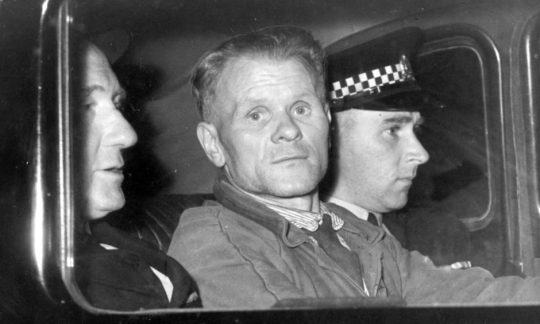
His life of detention began at age 18 when he was given a term in Borstal but later he served various terms in both Barlinnie and Peterhead Prisons. He eventually spent more time behind bars than outside. It's often easy to sentimentalise and sugar-coat the past, there was something about him which meant that even the police who snared him and the courts which he frequented as regularly as others visit their local supermarket, regarded him as somebody who was more interested in eluding an alarm and breaking a code than becoming rich from his forays.
Johnny was married during one of his spells out of prison and the couple had a baby daughter. But in 1934, while he was serving a sentence in Peterhead, he was told that his young wife was dead. He was refused permission to attend the funeral and Johnny's sense of justice was outraged. So he made the first of many escapes from the prison.
In 1942, he was serving yet another jail sentence in Peterhead Prison. The army offered to give him special commando training and Johnny accepted. After all, it meant he was out of prison, earning a wage - and fighting for his country. Part of a crack commando unit, he was dropped behind enemy lines and used his skills with both explosives and burglary to good effect, stealing important German documents.
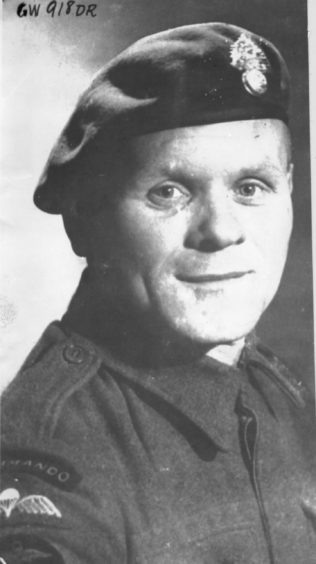
During the war in Italy, he entered Rome with the first troops to reach the city and blew open the safes in 14 foreign embassies - all in one day!
For his commando service and dangerous exploits, he was awarded the Military Medal and given a free pardon at the end of the war. But not longer after his return to Glasgow he was back to his life of burglary and was caught and jailed again.
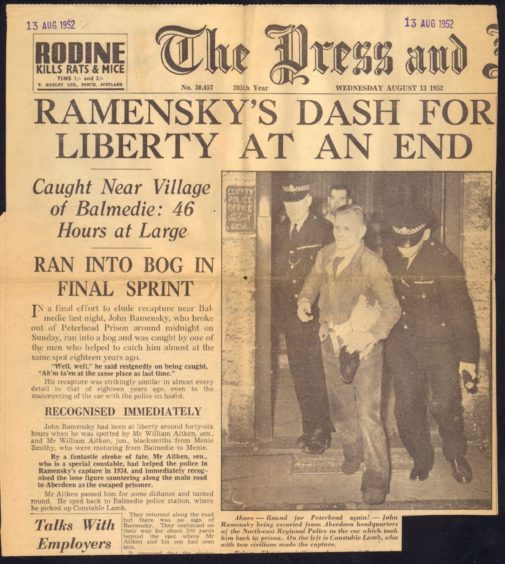
In November 1955 he was sentenced to 10 years’ "preventive detention" at Peterhead Prison, which should have given him a few privileges. But he found there were none. He served over two years with exemplary conduct and still there was no move to the better conditions of "preventive detention". So Johnny responded in the only way he knew how - he escaped. Of course, he was later recaptured but he was at least given an opportunity to put his case to the prison authorities - which achieved nothing. Johnny escaped (and was recaptured) from Peterhead (Scotland's strongest jail) no less than five times including three times in 1958. Sometimes the prison warders didn't know whether he was inside or outside the prison. His fifth escape evoked wide-spread sympathy amongst the public which was illustrated by a song "The Ballad of Johnny Ramensky" by Norman Buchan (a Member of Parliament), which was printed in the Scotsman newspaper, and another musical tribute, Let Ramensky Go, was penned by none other than Roddy McMillan, the star of Para Handy.
Not long after starting a prison sentence in Barlinnie in Glasgow, Johnny was in the exercise yard and suddenly threw off his boots and shot up the wall, using cracks in the mortar as toe-holds. He reached a roof - but could get no further. Equally, the warders couldn't get him down - and Johnny was demanding to see the Chief of the Prisons Department! Attempts to reach the roof were met by a barrage of roof slates - watched by a growing audience outside the prison walls. He stayed out on the roof for five hours, eventually coming down when it started to get cold.
In 1962 Detective Superintendent Robert Colquhoun (retired), said "Like most policemen who have come in contact with Ramensky, I find him an engaging character, the kind of man who, applying his brain to another, more acceptable, type of occupation, could probably have made good." Before he had retired, DS Colquhoun received a message from Johnny (who was once more in prison). He had heard that the policeman was seriously ill. The message contained his good wishes for his speedy recovery, plus the advice that he’d been taking too much out of himself chasing Johnny around! As he grew older and the escapes continued one question was being asked: Why does he keep on doing it, at his age and in his state of health? A police officer who knew him well said "Johnny never expects to get far when he breaks out now ... he's just got to do it to prove that he still can."
Johnny remarried and started a second family during his all too short periods out of prison but persisted in his life of crime into his old age - by which time his abilities as a cat burglar were beginning to fail him. In 1972 he collapsed in Perth Prison and died shortly after in hospital. In addition to his family, the many people who attended his funeral came from both the law enforcement and the law breaking sides of society. Whatever his faults, Johnny Ramensky was respected by them all. His obituary appeared in every Scottish national newspaper.
That's not the end of Johnny Gently though, he lives on at Peterhead Prison, now a museum where Ramensky served so many years behind bars, has created a exhibition space which highlights different aspects of his career.
I couldnae find the Roddy McMillan version of Lat Ramensky Go, but former BBC Young Traditional Musician of the Year, Claire Harings makes a great job of singing it, the lyrics below are the original version, Claire sings a slightly different version.
Let Ramensky Go
There was a lad in Glesga town, Ramensky was his name Johnny didnae know it then but he was set for fame
Now Johnny was a gentle lad, there was only one thing wrong He had an itch to strike it rich and trouble came along He did a wee bit job or two, he blew them open wide But they caught him and they tried him and they bunged him right inside
Alley-ee alley-ay alley-oo alley-oh Open up your prison gates And let Ramensky go
And when they let him out he said he'd do his best but then He yielded tae temptation and they bunged him in again Now Johnny made the headlines, entertained the boys below When he climbed up tae the prison roof and gave a one-man show
Alley-ee alley-ay alley-oo alley-oh Open up your prison gates And let Ramensky go
But when the war was raging the brass-hats had a plan Tae purloin some information, but they couldnae find a man So they nobbled John in prison, asked if he would take a chance Then they dropped him in a parachute beyond the coast of France
Alley-ee alley-ay alley-oo alley-oh Open up your prison gates And let Ramensky go
Then Johnny was a hero, they shook him by the hand For stealing secret documents frae the German High Command So Johnny was rewarded for the job he did sae well They granted him a pardon frae the prison and the cell
Alley-ee alley-ay alley-oo alley-oh Open up your prison gates And let Ramensky go
But Johnny was in error when he tried his hand once more For they caught him at a blastin', and it wasnae worth the score
The jury pled for mercy, but the judge's voice was heard Ten years without remission, and that's my final word Ten years, my lord, that's far too long, wee Johnny cried in vain For if you send me up for ten I'll never come out again
Oh give me another chance, my lord, I'm tellin' you no lie But if you send me up for ten I'll sicken and I'll die
Alley-ee alley-ay alley-oo alley-oh Open up your prison gates And let Ramensky go
Now Peterhead's a fortress, its walls are thick and stout But it couldnae hold wee Johnny when he felt like walking out Five times he took a powder, he left them in a fix And every day they sweat and pray in case he makes it six
Alley-ee alley-ay alley-oo alley-oh Open up your prison gates And let Ramensky go
Alley-ee alley-ay alley-oo alley-oh Open up your prison gates And let Ramensky go
Alley-ee alley-ay alley-oo alley-oh Open up your prison gates And let Ramensky go..........
Here are some reports on him.......[1958:] Twelve hours after Johnny Ramensky had done his fifth and most baffling "vanishing act" in Peterhead jail yesterday it was not known whether he was INSIDE or OUTSIDE the prison. This was admitted late last night by a Scottish Home Department spokesman. Here is the sequence of events leading up to the cracksman's third escape in ten months.
Because of rain, 45 prisoners, including Ramensky, were being exercised in one of Peterhead's large prison halls. At 1.40, the exercise ended and the squad began a 50 to 70-yard march, in organised lines to the tailor's shop. At 1.43, they arrived at the shop WITHOUT RAMENSKY.
The alarm was raised. Every corner of the prison was searched. But there was no trace of the "King of Peterhead". No rope or ladder with which he could have scaled the jail's 18-foot wall was found. One theory was that Ramensky had a key to the back door of the tailor's shop, which is only ten feet from the wall. For it is believed that he had a key for the tailor's shop door on his October break-out. Out went the word to police all over the country:
"Ramensky's free again."
Two hunts went on - in swirling snow and at temperatures below freezing point - for the 53-year-old convict who, despite ill-health, had made another freedom bid. Throughout the whole of the North of Scotland road blocks and police checks sprang up. Tracker dogs went out. A strong cordon was thrown round the immediate prison area. For on his last bid in October, Ramensky was found, after 40 hours of freedom only 200 yards from the prison. It was ill-health that beat him then. He collapsed after a child spotted him in a barn.[...].
Last night people living in the Peterhead area spoke of him without fear. For he is known as "Gentle John" and those beside the prison take bets on how long he will stay free. His escape in February this year lasted 24 hours, before he was caught in Peterhead's main street wearing a warder's cap and a long black coat.
One question was being asked: Why does he keep on doing it, at his age and in his state of health? A police officer who knows him well said last night: "Johnny never expects to get far when he breaks out now ... he's just got to do it to prove that he still can.
"Here is a description of the clothes worn by the wartime Commando who cracked safes behind enemy lines: Brown moleskin trousers, brown battledress tunic, brown jersey, blue and white striped shirt, black leather shoes ... and possibly wearing a cap. (Daily Record, Dec 18)
The six-day hunt for gentle Johnny Ramensky was called-off last night. And baffled police admitted: "There are still no clues." [...] The authorities believe that 53-year-old Ramensky, if still alive, is bound to make a mistake sometime, or to leave a clue somewhere. It is understood that police opinion is split over the reason for the absence of a "trail." Some feel he is dead in the sea, but others are convinced he is in the Peterhead area, possibly quite near the prison, and is being fed and sheltered. (Daily Record, Dec 23)
[1959:] Johnny Ramensky (53), the safe-breaker who made a sensational jail-break from Peterhead prison, remaining at liberty for nine days, is back in prison. He was caught at Persley, on the north bank of the River Don about three miles from Aberdeen. A police spokesman said after the capture that Ramensky was looking wonderfully well, apart from being footsore, and considering the long period he had been on the run. He was dressed in blue dungarees and a green jersey and his shoes were cracked and torn. It is understood that no police charges are impending against Ramensky on account of his escape. There have been no reports of break-ins or thefts. His fifth escape has evoked wide-spread sympathy amongst the public. During the war Ramensky was an instructor to Allied agents in blowing safes. (Weekly Scotsman, Jan 2)
#scotland#scottish highlands#criminal#cat burglar#sage cracker#soldier#hero#escape artist#history#peterhead#barlinnie
14 notes
·
View notes
Text
Pride special! Historical figures who were LGTB (edited with pride flags)
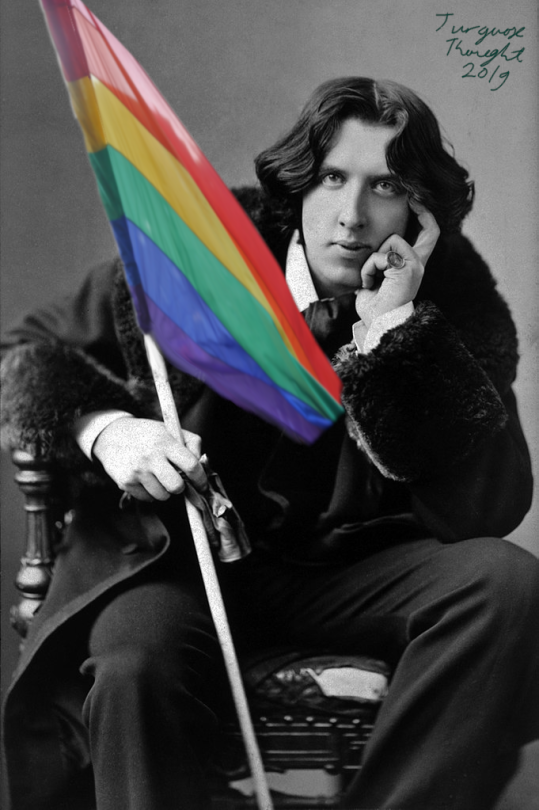
Oscar Wilde (1854-1900) - A famous Irish poet and playwright best known from his novel The Picture of Dorian Gray. Homoerotic subtext was featured in some of his works. He was very flamboyant and had multiple affairs with other men. One of these affairs was with his friend and lover Lord Alfred Douglas while being married with two sons. This relationship ultimately lead Wilde to be arrested and put in trial for sodomy which he was found guilty. In 1895 he was sentenced in two years of hard labour. After his release from prison, he moved to France and lived in mid-1897 with Ronald Ross. Later that year he met with Douglass and they lived in Naples but separated because of the financial pressure from their families (who didn’t accept their meeting) and personal reasons.
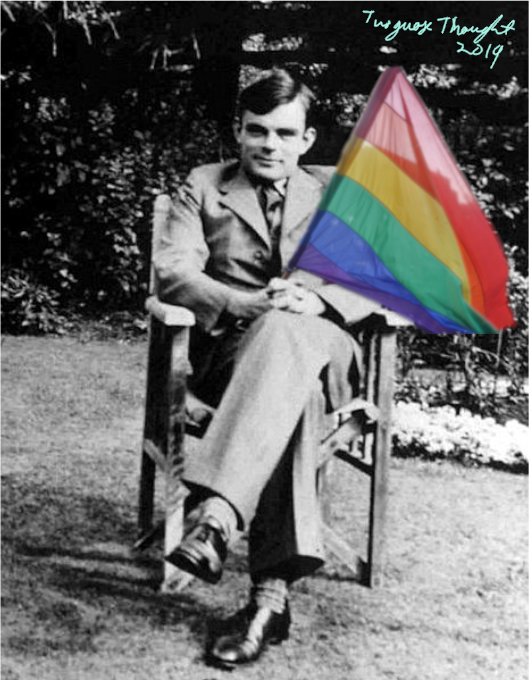
Alan Turin (1912-1954) - British logician, computer scientist, and mathematician. His most influential work is Turing Machine which can be seen as a model of a modern computer. In 1952 he was charged with gross indecency after admitting his sexual relationship with Arnold Murray. Homosexual acts were illegal during that time in the United Kindom. He was given a choice to either go to prison or parole including his agreement to undergo hormonal physical changes designed to reduce libido. He chose the later and the treatment caused impotent and gynecomastia.

Pjotr Tšaikovski (1840-1893) - Classic Russian composer. He composed many masterpieces such as Swanlake and The Nutcracker. He suffered from bad mental health and was reclusive and shy. It is under debate that Tšaikovski might have had a hard time accepting his own sexuality. Sergey Kireyev was his first, and according to his brother’s diary his “strongest, longest and purest love”.

Frida Kahlo (1907-1953) - Mexican painter who is known from her colourful, yet dark-themes paintings. Based on her own experience, women’s harsh life and pain are expressed in her art, making her almost a feminist cult person in the 90s. She was openly bisexual and was friends with Pablo Picasso.

Joséphine Baker (1903-1975) - American-French dancer, singer and stage artist. She was openly bisexual and very famous in her time for her revealing costumes, dance performances and exotic beauty. She was also an activist against racism and worked as an honourable correspondent for France during World War II, gathering information about German troop locations. Baker was openly bisexual.
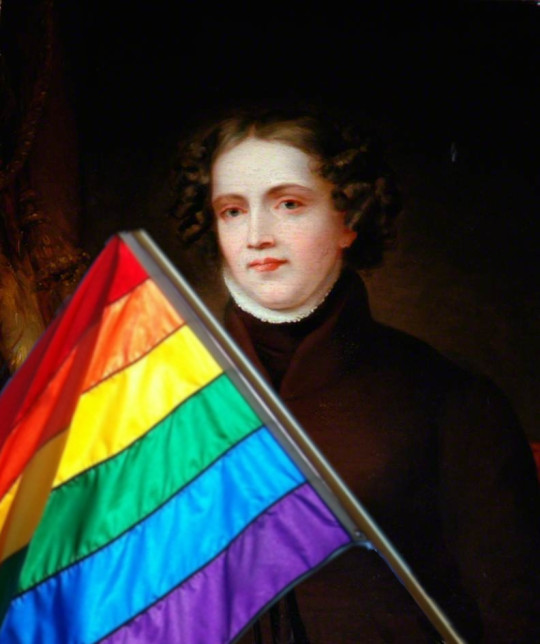
Anne Lister (1791-1840) - Considered to be the first modern lesbian for her openly gay lifestyle, Lister was an English landowner and diarist, who wrote about her life in detail, including her lesbian relationships containing intimate details about them (these parts written in code) to her diaries that are over 4 million words long. She took care of business and travelled a lot during her life. Lister was in a relationship with Ann Walker and in 1834 they took communion together in Holy Trinity Church and thereafter considered themselves married. A Historical drama series Gentleman Jack was released this year and it tells her story based on her diaries.

Chevalier d’Éon (1728-1810) - A French diplomat and spy who was also a soldier in the Seven Years’ War. While working in London as a spy, d’Èon was rumoured to be a woman despite wearing dragoon’s uniform and serving the king as a man. People started betting on d'Éon true sex. D'Éon declined the invitation to be examined for it would have been dishonouring whatever the result. Later on, d'Éon was in political exile in London (after a series of events), unable to return to France but after the death of Louis XV d'Éon tried to negotiate on his return to France. D'Éon was allowed to return but with the condition that he would turn over the correspondence regarding the secret du roi (King Louis XV’s secret channel of diplomats d'Éon worked in) D'Éon returned but claimed to be born as a woman and raised as a boy. D'Éon demanded to be recognized as a woman by the government. The government accepted this but demanded d'Éon to wear appropriately female clothing. D'Éon agreed and returned to France and lived as a woman until death. D'Éon’s dead body was examined and confirmed to have had male organs yet having feminine characteristics. This might be evidence to d'Éon being intersex.

Dr. Alan L. Hart (1890-1962) - An American physician, tuberculosis researcher, radiologist, writer and novelist who was one of the first trans men to undergo hysterectomy and gonadectomy in the USA (1917-18). He pioneered x-ray photography which was used to detect tuberculosis. Dr Hart also wrote short stories and four novels during his career. Gay men and gender dysphoria are portrayed in his writing.

Roberta Cowell (1918-2011) - A British racing driver and a fighter pilot in World War II. Cowell was the first known trans woman to undergo sex reassignment surgery. In 1940 she was commissioned in Royal army service corps. While serving as a pilot officer in Germany Cowell attacked enemy targets on the ground but crash-landed and was captured by German troops. Her too escape attempts failed and she was eventually taken to Stalag Luft I where she remained as a prisoner for five months until the camp was abandoned because of the pressure from Red Army. After the war, Cowell began her transition and became friends with Michael Dillon.
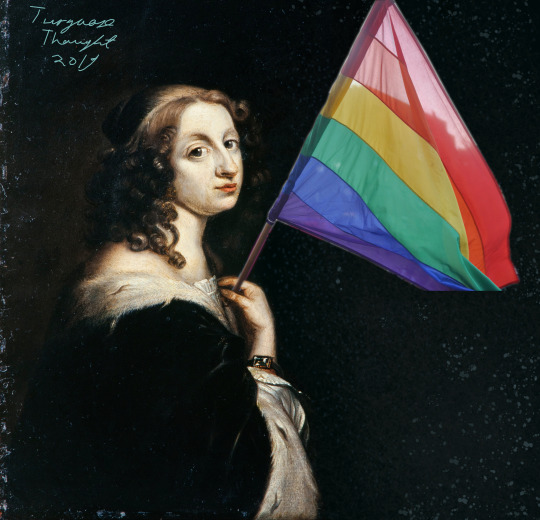
Queen Christina (1626-1698) - Queen of Sweden from 1632 to 1654. One of the most educated women in the 17th century, who was interested in books, painting, sculptures and manuscripts. She even called great philosopher Rene Descartes to teach her. Christina never married which was considered scandalous. She also felt strong loath towards actives that were considered feminine during her life time and preferred hunting, fencing and riding instead. Her sexuality is under debate, but some historians consider her to have been lesbian.
(fun fact, I’ve seen this portrait life recently)
BONUS: Leonardo Da Vinci in pride colours

These are only few amazing people I have mentioned and there is plenty of many others so don’t be afraid to add people who are not mentioned or correct me if I have errors
#pride#leonardo da vinci#queen christina#alan hart#alan turing#oscar wilde#josephine baker#fridakahlo#chevalier d'eon#anne lister#tsaikovski#pjort tsaikovski#history#lgtb history#lgtb#lgtb pride
4K notes
·
View notes
Text
Maaarine: bibliography 2019
Books posted on this blog in 2019 (other years: #biblioindex)
Margaret ARCHER and Pierpaolo DONATI (2015): The Relational Subject
Hannah ARENDT (1963): Eichmann in Jerusalem
Lundy BANCROFT (2002): Why Does He Do That? Inside the Minds of Angry and Controlling Men
Gregory BATESON (1979): Mind and Nature: A Necessary Unity
Ernst CASSIRER (1910): Substance and Function and Einstein’s Theory of Relativity
Ernst CASSIRER (1942): The Logic of the Humanities
Ernst CASSIRER (1975): An Essay on Man
Antonio DAMASIO (1994): Descartes’ Error: Emotion, Reason, and the Human Brain
Antonio DAMASIO (2003): Looking for Spinoza: Joy, Sorrow, and the Feeling Brain
Stephen DARWALL (2002): Welfare and Rational Care
Merve EMRE (2018): The Personality Brokers: The Strange History of Myers-Briggs and the Birth of Personality Testing
Ronan FARROW (2019): Catch and Kill: Lies, Spies and a Conspiracy to Protect Predators
Peter FONAGY (2002): Affect Regulation, Mentalization and the Development of the Self
Suzanne GIESER (1995): The Innermost Kernel — Depth Psychology and Quantum Physics
Françoise GILOT (1964): Life with Picasso
David GRAEBER (2011): Debt: The First 5000 Years
David GRAEBER (2018): Bullshit Jobs: A Theory
Aron GURWITSCH (1964): The Field of Consciousness
Aron GURWITSCH (1966): Studies in Phenomenology and Psychology
Hubert HERMANS and Agnieszka HERMANS-KONOPKA (2006): Dialogical Self Theory: Positioning and Counter-Positioning in a Globalizing Society
Tor HERNES (2007): Understanding Organization as Process: Theory for a Tangled World
Francis HEYLIGHEN (1990): Representation and Change
Francis HEYLIGHEN (2000): Principia Cybernetica
James HILLMAN (1975): Re-visioning Psychology
James HILLMAN (1996): The Soul’s Code
Jeremy HOLMES (1983): John Bowlby and Attachment Theory
Jeremy HOLMES (2009): Exploring in Security: Towards an Attachment-Informed Psychoanalytic Psychotherapy
William JAMES (1902): The Varieties of Religious Experience
Carl JUNG (1921): Psychological Types
Carl JUNG (1934): The Soul and Death
Carl JUNG (1951): Aion: Researches into the Phenomenology of the Self
Carl JUNG (1961): Memories, Dreams, Reflections
Jerome KAGAN and Nancy SNIDMAN (2004): The Long Shadow of Temperament
Bernardo KASTRUP (2019): The Idea of the World: A Multi-Disciplinary Argument for the Mental Nature of Reality
Eugene KELLY (1997): Structure and Diversity: Studies in the Phenomenological Philosophy of Max Scheler
Eugene KELLY (2011): Material Ethics of Value: Max Scheler and Nikolai Hartmann
Ian KERSHAW (2008): Hitler
Hugh LACEY (1999): Is Science Value-Free? Values and Scientific Understanding
George LAKOFF (1987): Women, Fire, and Dangerous Things: What Categories Reveal about the Mind
George LAKOFF (1999): Philosophy in the Flesh: The Embodied Mind and its Challenge to Western Thought
Ervin LASZLO (1963): Essential Society — An Ontological Reconstruction
Ervin LASZLO (1963): Individualism, Collectivism, and Political Power
Kate MANNE (2017): Down Girl: The Logic of Misogyny
Maurice MERLEAU-PONTY (1953): The Structure of Behavior
Robert MERTON (1948): The Self-Fulfilling Prophecy
Gerald MIDGLEY (2000): Systemic Intervention: Philosophy, Methodology, and Practice
John MINGERS (1994): Self-Producing Systems: Implications and Applications of Autopoiesis
Kevin MITCHELL (2018): Innate: How the Wiring of Our Brains Shapes Who We Are
George ORWELL (1949): Nineteen Eighty-Four
Philippe ROCHAT (2009): Others in Mind: Social Origins of Self-Consciousness
Philippe ROCHAT (2014): Origins of Possession: Owning and Sharing in Development
Sally ROONEY (2018): Normal People
Arthur SCHOPENHAUER (1819): The World as Will and Representation
Alfred SCHUTZ (1962): The Problem of Social Reality
David SHAPIRO (1981): Autonomy and Rigid Character
Timothy SNYDER (2015): Black Earth: The Holocaust as History and Warning
Dan SPERBER and Hugo MERCIER (2017): The Enigma of Reason: A New Theory of Human Understanding
Jason STANLEY (2018): How Fascism Works: The Politics of Us and Them
Keith STANOVICH (2011): Rationality and the Reflective Mind
Murray STEIN (1998): Jung’s Map of the Soul
Anthony STEVENS (2002): Archetype Revisited: An Updated Natural History of the Self
Richard TARNAS (1991): The Passion of the Western Mind: Understanding the Ideas That Have Shaped Our Worldview
Volker ULLRICH (2013): Hitler: Volume 1 — Ascent 1889-1939
Hans VAIHINGER (1913): The Philosophy of ‘As-If’: A System of the Theoretical, Practical and Religious Fictions of Mankind
Norbert WILEY (2016): Inner Speech and the Dialogical Self
A.L. WILKES (1997): Knowledge in Minds: Individual and Collective Processes in Cognition
Other years: #biblioindex
15 notes
·
View notes
Text
Okay.
Let’s try break down the timeline of the Ruby Redfort/Spectrum “universe” prior to Ruby being an agent.
We begin knowing some basic information about some of our agent’s ages and here’s where the spoilers! begin:
In 1938, we know that Casey Morgan aka Buzz is 8 years old. We also know from the flashback pages [173,184] in Blink and You Die, hereby abbreviated as BYD, that when Buzz is 8, Bradley is 13. And due to the Ghost Files saying so, and his age in ‘73 being 42, we know Hitch is 7. LB’s age is, to my knowledge, never given an exacting date, but I’d assume it’s somewhere between 10-13 in ‘38. Let’s say she’s 12.
In an unspecified month during 1938, Buzz applies for the Larvae programme, is accepted and two months later is introduced to Bradley Baker. She decides to kill Baker after being angered by his perfectness, and pushes him into a river, as well as throwing Hitch to the crocodiles.
This occurs in an unspecified area of Australia, so I can’t use the concept of a frozen river to say if this is in summer or winter but it’s irrelevant what season it is. I care though so, from my research on crocodiles in Australia, since the crocodile experience was so traumatic for Hitch that he blocked the memories out, it’s more likely that they were saltwater/estuarine crocodiles (known for being more aggressive). I can’t determine exactly where this occurred (and thus where LB lived) but saltwater crocs live in the Sundaland region of Australia, so this was somewhere in Northern Australia.
Skip to approx 1942. LB is stated by Blacker as having joined Spectrum “a few years on” after the Australia incident [page 355, BYD] so we can assume she’s around 16 when she becomes the first female agent. Hitch is now 11.
From the picture seen in LB’s office of Hitch pulling faces at an animatronic crocodile at Disneyland [Look Into My Eyes (LIME) page 128, BYD page 291] that he “could only have been about twenty or so in the picture”. For Hitch to be 20, the Disneyland trip must have occurred in 1951. LB is 25ish, Bradley is 26. (Unimportant fact but there’s no way two 25 year olds (who are dating) agreed to go on a trip with just one other person who was 20 at the time, so there must have been other people on the trip. Was this an annual Disneyland Spectrum visit? Do they do that?)
Detour from our Spectrum workers - Ruby Redfort is born in 1960! This we know from the fact that the books occur in 1973 (see below) and her age from the dust jacket of the LIME book, which states “What would you do if you were a thirteen year-old kid and a secret agency asked you to become their ace code-cracker?” [obviously no page number, but it cost me £12.99 if you wanna know. I’ve written my name in invisible ink on the front page but heat has made it a little less invisible, because it’s been knocking around since 2011]
Bradley says he’s been “dead for eleven years” [BYD, page 351] in 1973, meaning he was killed by LB in 1962. This leaves a strange margin of error in the Hitch-Bradley department, as Hitch openly states that “we (he and Bradley) worked in the same department for about seven years straight” [BYD, page 337] and it’s canon Hitch has been friends with LB and likely Baker since 1951. However, I guess you don’t have to work with someone to be friends with them.
In the same year as Bradley’s ‘death’, 1962 is the year Homer Pinkerton’s dog is stolen and Ruby finds the Larvae badge. This is shown by the beginning of LIME stating “It was a crisp October day in Cedarwood Drive and a two year old girl was standing on a high stool...” [page 8] and “(Ruby, age 2) found a small tin badge embossed with an image of something.” [page 10]
The rest of the period of time between 1962 and 1973, the year of all the books occurring as signified by the 1974 New Year Eye Ball Party - “Clancy opened his eyes. ‘Happy new year, Mrs Redfort,’ he groaned.” and “‘How jolly!’ cried Sabrina. ‘How tout à fait joyeux! Our own little party! What a way to welcome in 1974!’” [BYD, page 522].
So, maybe this giant wall of text is making your brain hurt. So here’s a handy little timeline, although it’s blurry as all hell so you’ll have to click on it and it;’s much more simplified:

66 notes
·
View notes
Text
Software bugs
Software bugs are the terms we often hear being used by IT professionals. As curious as it sounds, bugs are ideally the informal defects a software contains in the process of building and existence.
In other words, Bug is the name of defects that pop up when the application or software doesn’t work properly. It usually happens when the developer mistakenly brings an error in the process of software or application development. Software bugs are usually caught during the testing phase of the software development life cycle. However, some of the bugs may go undetected during the testing phase. Software tester, who is responsible for checking on bugs, holds one of the critical positions in any organisation that creates and develops software or applications. To become a software tester, join Srishti campus, the best software training institute in Trivandrum.
How Does A Software Bug Occur?
If the software bugs don’t go through timely identification and checks, there are huge chances of the software getting crashed or locked up. For example, if one of the programs were to add sums together, the bugs would make them subtract, leading to a wrong solution.
In the health industry, if the software reads errored commands with bugs, the radiation could lead to serious health consequences for the patient.
Bugs That Made History!
During the 1980s, bugs in the code controlling the radiation therapy machine Therac-25 led to patient deaths.
An on-board guidance computer bug caused a $1.0 billion rocket called Ariane 5 to explode seconds after launch in 1996.
Mariner I’s flight software was corrupted in 1962, causing the rocket to change path from the expected path.
Many computers crashed when a bug was found in AT&T’s software control #4ESS long distance switches in the 1990s.
How Are Software Identified?
One of the most important phases of the software development life cycle is testing. Ideally, testing should occur after design, and it can occur both during the overall development process and after the design process has been completed. In order to ensure that the software or app operates as intended and that it remains stable during use, robust testing is needed. Bugs are identified and fixed during this testing period.
Identifying software bugs is made easier with a wide range of solutions available to software developers. Defensive programming solutions, for instance, help to identify typographical bugs and the unit testing methods facilitate the developer to test and function every part of the software.
Learning software testing opens up a strong career choice, helping one to ascend in the IT industry. To experience the best software testing training in Trivandrum, Srishti Campus opens up opportunities for the best career.
0 notes
Text
MARRIAGE
Article 412: No entry in a civil register shall be changed or corrected, without a judicial order. (n)
Baybayan v. Republic of the Philippines
FACTS:
The foregoing judgment was entered upon petition of Consuelo Calicdan Baybayan, filed in the court aforesaid on October 12, 1962, praying that the certificate of birth of her son, Bartolome Calicdan Baybayan, Jr., be corrected "to make it appear in said certificate that the place of birth of his father, Bartolome E. Baybayan, is Urdaneta, Pangasinan, and his citizenship is Filipino" (Rec. App. p. 3) on the ground that petitioner’s mother, Valentina Garcia, whom she had requested to register the birth of the boy in the Office of the Local Civil Registrar of Bugallon, Pangasinan, made a mistake in giving the birthplace of her husband as Balungao, Pangasinan, and his citizenship as American.
The court caused copies of the petition to be served on the Solicitor General, the Provincial Fiscal, and the Local Civil Registrar. The Republic of the Philippines, through the Solicitor General and Provincial Fiscal, opposed the petition, claiming that the court had no jurisdiction to order such substantial changes as those prayed for in a summary proceeding under Article 412 of the Civil Code, as repeatedly decided by this Supreme Court.
ISSUE:
WON the court had no jurisdiction to order such substantial changes as those prayed for in a summary proceeding under Article 412 of the Civil Code, as repeatedly decided by this Supreme Court.
HELD:
The decision must be reversed. It has been the uniform jurisprudence of this Court, that substantial alterations, such as those affecting the status and citizenship of a person in the Civil Registry records, can not be ordered by the court unless first threshed out in an "appropriate action wherein all parties who may be affected by the entries are notified or represented" (see Rule 108 of the Revised Rules of Court), and that the summary proceedings under Article 412 of the Civil Code only justify an order to correct innocuous or clerical error, such as misspellings and the like, errors that are visible to the eyes or obvious to the understanding.
"For the information of the parties concerned, and for the guidance of the public in general, we may venture the opinion that the clerical errors which might be corrected through judicial sanction under Article 412 of the new Civil Code would be those harmless and innocuous changes, such as correction of a name that is clearly misspelled, occupation of the parents, etc.; but for changes involving the civil status of the parents, their nationality or citizenship, those are grave and important matters which may have a bearing and effect on the citizenship and nationality not only of said parents, but of the offsprings, and to seek said changes, it is necessary to file a proper suit wherein not only the State, but also all parties concerned and affected should be made parties defendants or respondents, and evidence should be submitted, either to support the allegations of the petition or complaint, or also to disprove the same so that any order or decision in the case may be made with due process of law and on the basis of facts proven. Then and only then may the change or changes be made in the entry in a civil register that will affect or even determine conclusively the citizenship or nationality of a person therein involved."
0 notes
Text
Prototype Asteroids-Like Development
For my Asteroids-like prototype, I decided to forgo the physical prototype. This was done due to time constraints. As this was an Asteroid-Like, I wanted to focus on the movement of the spacecraft while adding a few unique mechanics of my own. This meant the controls had to keep the feel of the classic asteroids game, the rotate left, rotate right, thrust and fire. Tracy Fullerton describes the same control scheme of Spacewar from 1962 in chapter 8 of her book Game Design Workshop; she also explained that Spacewar was programmed by Steve Russell and several other MIT students and is often credited as the first digital game. This classic feel of the controls was achieved by a lot of trial and error with GDevelops physics engine.

This allowed a force to be applied to the player object giving the feeling of thrust and positive and negative torque to provide the left and right rotation.

Next to tackle was the fire, and thanks to GDevelop, this was relatively easy.

For the asteroids, I wanted them to spawn in, but I also wanted them to feel like they appeared from the depths of space rather than just popping in. When an asteroid spawned in, I set the opacity to 0 and then increased it by one every frame until the opacity reached its maximum at 255. This resulted in the exact effect that I wanted.

Now that all the classic elements had been added, it was time to add my mechanics to the game. First off, I added a tractor beam. This was added to alter the gameplay from destroying all the asteroids to getting them small enough to suck up. To make the effect feel like a tractor beam, I used the Tween behaviour in GDevelop.

For health, I want to add a shield that is depleted with every asteroid hit, and this is where I hit my problem. The shield asset I wanted to use is a crescent shape meaning that the shield would have to be rotated to the point of impact. A lot of maths was done to try to get this to happen with no luck. I was about to give up on the idea until I had a poke around in GDevelop and found they had already provided a way to do this with the code snippet {Change the angle of [Child Object]: set to [Parent Object].AngleToObject(Object to face)}. So once again, it was just a lack of knowledge that could have saved some time. However, I do feel my experience with GDevelop has grown exponentially between my platformer and now.

To add to that gameplay, I added a space station so that you could take your collected asteroids to get some Coin for them. I hope that later, I could add some shop where you could buy upgrades and things for your ship.
Finally, I added some UI elements so that the player can track how complete their inventory is and how much Coin and shields they have. However, I could not find a modulus operator which would have helped display the Coin. I am sure there is one some were in GDevelop I just have to find it.
To finish off, I would like to thank https://www.kenney.nl/ for the royalty-free asset that I have been using in my prototype. I would also like to add that I have enjoyed making this prototype and would like to expand upon it, if not in IGB220, as a side project because I can see a lot of potential in this game.
Sources:
Tracy Fullerton. (2018) Game Design Workshop : A Playcentric Approach to Creating Innovative Games, Fourth Edition. Retrieved July 29, 2022, from https://ebookcentral.proquest.com/lib/qut/reader.action?docID=54776988
0 notes
Text
Events 1.1
Pre-Julian Roman calendar
153 BC – For the first time, Roman consuls begin their year in office on January 1. Early Julian calendar (before Augustus' leap year correction) 45 BC – The Julian calendar takes effect as the civil calendar of the Roman Empire, establishing January 1 as the new date of the new year. 42 BC – The Roman Senate posthumously deifies Julius Caesar.
Julian calendar
193 – The Senate chooses Pertinax against his will to succeed Commodus as Roman emperor. 404 – Saint Telemachus tries to stop a gladiatorial fight in a Roman amphitheatre, and is stoned to death by the crowd. This act impresses the Christian Emperor Honorius, who issues a historic ban on gladiatorial fights. 417 – Emperor Honorius forces Galla Placidia into marriage to Constantius, his famous general (magister militum) (probable). 1001 – Grand Prince Stephen I of Hungary is named the first King of Hungary by Pope Sylvester II (probable). 1068 – Romanos IV Diogenes marries Eudokia Makrembolitissa and is crowned Byzantine Emperor. 1259 – Michael VIII Palaiologos is proclaimed co-emperor of the Empire of Nicaea with his ward John IV Laskaris. 1438 – Albert II of Habsburg is crowned King of Hungary. 1502 – The present-day location of Rio de Janeiro, Brazil, is first explored by the Portuguese. 1515 – Twenty-year-old Francis, Duke of Brittany, succeeds to the French throne following the death of his father-in-law, Louis XII. 1527 – Croatian nobles elect Ferdinand I of Austria as King of Croatia in the Parliament on Cetin. 1600 – Scotland recognises January 1 as the start of the year, instead of March 25. 1651 – Charles II is crowned King of Scotland. 1700 – Russia begins using the Anno Domini era instead of the Anno Mundi era of the Byzantine Empire.
Gregorian calendar
1707 – John V is proclaimed King of Portugal and the Algarves in Lisbon. 1739 – Bouvet Island, the world's remotest island, is discovered by French explorer Jean-Baptiste Charles Bouvet de Lozier. 1772 – The first traveler's cheques, which could be used in 90 European cities, are issued by the London Credit Exchange Company. 1773 – The hymn that became known as "Amazing Grace", then titled "1 Chronicles 17:16–17", is first used to accompany a sermon led by John Newton in the town of Olney, Buckinghamshire, England. 1776 – American Revolutionary War: Norfolk, Virginia is burned by combined Royal Navy and Continental Army action. 1776 – General George Washington hoists the first United States flag, the Grand Union Flag, at Prospect Hill. 1781 – American Revolutionary War: One thousand five hundred soldiers of the 6th Pennsylvania Regiment under General Anthony Wayne's command rebel against the Continental Army's winter camp in Morristown, New Jersey in the Pennsylvania Line Mutiny of 1781. 1788 – First edition of The Times of London, previously The Daily Universal Register, is published. 1801 – The legislative union of Kingdom of Great Britain and Kingdom of Ireland is completed, and the United Kingdom of Great Britain and Ireland is proclaimed. 1801 – Ceres, the largest and first known object in the Asteroid belt, is discovered by Giuseppe Piazzi. 1803 – Emperor Gia Long orders all bronze wares of the Tây Sơn dynasty to be collected and melted into nine cannons for the Royal Citadel in Huế, Vietnam. 1804 – French rule ends in Haiti. Haiti becomes the first black-majority republic and second independent country in North America after the United States. 1806 – The French Republican Calendar is abolished. 1808 – The United States bans the importation of slaves. 1810 – Major-General Lachlan Macquarie officially becomes Governor of New South Wales. 1822 – The Greek Constitution of 1822 is adopted by the First National Assembly at Epidaurus. 1834 – Most of Germany forms the Zollverein customs union, the first such union between sovereign states. 1847 – The world's first "Mercy" Hospital is founded in Pittsburgh, United States, by a group of Sisters of Mercy from Ireland; the name will go on to grace over 30 major hospitals throughout the world. 1860 – The first Polish stamp is issued, replacing the Russian stamps previously in use. 1861 – Liberal forces supporting Benito Juárez enter Mexico City. 1863 – American Civil War: The Emancipation Proclamation takes effect in Confederate territory. 1877 – Queen Victoria of the United Kingdom is proclaimed Empress of India. 1885 – Twenty-five nations adopt Sandford Fleming's proposal for standard time (and also, time zones). 1890 – Eritrea is consolidated into a colony by the Italian government. 1892 – Ellis Island begins processing immigrants into the United States. 1898 – New York, New York annexes land from surrounding counties, creating the City of Greater New York. The four initial boroughs, Manhattan, Brooklyn, Queens, and The Bronx, are joined on January 25 by Staten Island to create the modern city of five boroughs. 1899 – Spanish rule ends in Cuba. 1901 – The Southern Nigeria Protectorate is established within the British Empire. 1901 – The British colonies of New South Wales, Queensland, Victoria, South Australia, Tasmania, and Western Australia federate as the Commonwealth of Australia; Edmund Barton is appointed the first Prime Minister. 1902 – The first American college football bowl game, the Rose Bowl between Michigan and Stanford, is held in Pasadena, California. 1910 – Captain David Beatty is promoted to Rear admiral, and becomes the youngest admiral in the Royal Navy (except for Royal family members) since Horatio Nelson. 1912 – The Republic of China is established. 1914 – The SPT Airboat Line becomes the world's first scheduled airline to use a winged aircraft. 1923 – Britain's Railways are grouped into the Big Four: LNER, GWR, SR, and LMS. 1927 – New Mexican oil legislation goes into effect, leading to the formal outbreak of the Cristero War. 1928 – Boris Bazhanov defects through Iran. He is the only assistant of Joseph Stalin's secretariat to have defected from the Eastern Bloc. 1929 – The former municipalities of Point Grey, British Columbia and South Vancouver, British Columbia are amalgamated into Vancouver. 1932 – The United States Post Office Department issues a set of 12 stamps commemorating the 200th anniversary of George Washington's birth. 1934 – Alcatraz Island in San Francisco Bay becomes a United States federal prison. 1934 – A "Law for the Prevention of Genetically Diseased Offspring" comes into effect in Nazi Germany. 1942 – The Declaration by United Nations is signed by twenty-six nations. 1945 – World War II: In retaliation for the Malmedy massacre, U.S. troops kill 60 German POWs at Chenogne. 1945 – World War II: The German Luftwaffe launches Operation Bodenplatte, a massive, but failed, attempt to knock out Allied air power in northern Europe in a single blow. 1947 – Cold War: The American and British occupation zones in Allied-occupied Germany, after World War II, merge to form the Bizone, which later (with the French zone) became part of West Germany. 1947 – The Canadian Citizenship Act 1946 comes into effect, converting British subjects into Canadian citizens. Prime Minister William Lyon Mackenzie King becomes the first Canadian citizen. 1948 – The British railway network is nationalized to form British Railways. 1949 – United Nations cease-fire takes effect in Kashmir from one minute before midnight. War between India and Pakistan stops accordingly. 1956 – Sudan achieves independence from Egypt and the United Kingdom. 1957 – George Town, Penang, is made a city by a royal charter of Queen Elizabeth II of the United Kingdom. 1957 – Lèse majesté in Thailand is strengthened to include "insult" and changed to a crime against national security, after the Thai criminal code of 1956 went into effect.:6,18 1958 – The European Economic Community is established. 1959 – Cuban Revolution: Fulgencio Batista, dictator of Cuba, is overthrown by Fidel Castro's forces. 1960 – Cameroon achieves independence from France and the United Kingdom. 1962 – Western Samoa achieves independence from New Zealand; its name is changed to the Independent State of Western Samoa. 1964 – The Federation of Rhodesia and Nyasaland is divided into the independent republics of Zambia and Malawi, and the British-controlled Rhodesia. 1965 – The People's Democratic Party of Afghanistan is founded in Kabul, Afghanistan. 1970 – The defined beginning of Unix time, at 00:00:00. 1971 – Cigarette advertisements are banned on American television. 1973 – Denmark, Ireland and the United Kingdom are admitted into the European Economic Community. 1976 – A bomb explodes on board Middle East Airlines Flight 438 over Qaisumah, Saudi Arabia, killing all 81 people on board. 1978 – Air India Flight 855, a Boeing 747, crashes into the Arabian Sea off the coast of Bombay, India, due to instrument failure, spatial disorientation, and pilot error, killing all 213 people on board. 1979 – Normal diplomatic relations are established between the People's Republic of China and the United States. 1981 – Greece is admitted into the European Community. 1982 – Peruvian Javier Pérez de Cuéllar becomes the first Latin American to hold the title of Secretary-General of the United Nations. 1983 – The ARPANET officially changes to using TCP/IP, the Internet Protocol, effectively creating the Internet. 1984 – The original American Telephone & Telegraph Company is divested of its 22 Bell System companies as a result of the settlement of the 1974 United States Department of Justice antitrust suit against AT&T. 1984 – Brunei becomes independent of the United Kingdom. 1985 – The first British mobile phone call is made by Michael Harrison to his father Sir Ernest Harrison, chairman of Vodafone. 1987 – The Isleta Pueblo tribe elect Verna Williamson to be their first female governor. 1988 – The Evangelical Lutheran Church in America comes into existence, creating the largest Lutheran denomination in the United States. 1989 – The Montreal Protocol comes into force, stopping the use of chemicals contributing to ozone depletion. 1990 – David Dinkins is sworn in as New York City's first black mayor. 1993 – Dissolution of Czechoslovakia: Czechoslovakia is divided into the Czech Republic and Slovak Republic. 1994 – The Zapatista Army of National Liberation initiates twelve days of armed conflict in the Mexican state of Chiapas. 1994 – The North American Free Trade Agreement (NAFTA) comes into effect. 1995 – The World Trade Organization comes into being. 1995 – The Draupner wave in the North Sea in Norway is detected, confirming the existence of freak waves. 1995 – Austria, Finland and Sweden join the EU. 1998 – Following a currency reform, Russia begins to circulate new rubles to stem inflation and promote confidence. 1999 – Euro currency is introduced in 11 member nations of the European Union (with the exception of the United Kingdom, Denmark, Greece and Sweden; Greece adopts the euro two years later). 2004 – In a vote of confidence, General Pervez Musharraf wins 658 out of 1,170 votes in the Electoral College of Pakistan, and according to Article 41(8) of the Constitution of Pakistan, is "deemed to be elected" to the office of President until October 2007. 2007 – Bulgaria and Romania join the EU. 2007 – Adam Air Flight 574 breaks apart in mid-air and crashes near the Makassar Strait, Indonesia, killing all 102 people on board. 2009 – Sixty-six people die in a nightclub fire in Bangkok, Thailand. 2010 – A suicide car bomber detonates at a volleyball tournament in Lakki Marwat, Pakistan, killing 105 and injuring 100 more. 2011 – A bomb explodes as Coptic Christians in Alexandria, Egypt, leave a new year service, killing 23 people. 2011 – Estonia officially adopts the Euro currency and becomes the 17th Eurozone country. 2013 – At least 60 people are killed and 200 injured in a stampede after celebrations at Félix Houphouët-Boigny Stadium in Abidjan, Ivory Coast. 2015 – The Eurasian Economic Union comes into effect, creating a political and economic union between Russia, Belarus, Armenia, Kazakhstan and Kyrgyzstan. 2017 – An attack on a nightclub in Istanbul, Turkey, during New Year's celebrations, kills at least 39 people and injures more than 60 others.
3 notes
·
View notes
Photo

How to Troubleshoot “No Operating System Found” Error Code 1962? If your computer system creates a problem in booting, don’t worry this is a ordinary issue in Windows 10 OS despite some other device models.
0 notes
Text
Overview- Details and Syllabus for IBPS Clerk Exam

About IBPS Clerk Exam
IBPS is an autonomous body that conducts the recruitment process of IBPS Clerk exam once every year.
Any eligible candidate who aspires to join as Clerk (CRP Clerk IX) in the participating organisations (Indian Banks) can apply for the IBPS Clerk examination.
The details of the IBPS Clerk examination along with scheme and syllabus of the IBPS Clerk exam are given below.
Eligibility for IBPS Clerk exam
Nationality / Citizenship
A candidate must be either:
A Citizen of India or
A subject of Nepal or
A subject of Bhutan or
A Tibetan Refugee who came over to India before 1st January 1962 with the intention of permanently settling in India or
A person of Indian origin who has migrated from Pakistan, Burma, Sri Lanka, East African countries of Kenya, Uganda, the United Republic of Tanzania (formerly Tanganyika and Zanzibar), Zambia, Malawi, Zaire, Ethiopia and Vietnam with the intention of permanently settling in India,
Provided that a candidate belonging to categories 2, 3, 4 and 5 shall be a person n whose favour a certificate of eligibility has been issued by the Government of India.
Educational Qualification
The minimum qualification required for IBPS Clerk exam is Graduation in any discipline from a University recognised by the Govt. of India or any equivalent qualification recognized as such by the Central Government.
To apply for IBPS Clerk exam, the candidate must possess valid Mark-sheet / Degree Certificate that he/ she is a graduate on the he / she registers and indicate the percentage of marks obtained in Graduation while registering online.
Computer Literacy: Operating and working knowledge in computer systems is mandatory i.e. candidates should have Certificate/Diploma/Degree in computer operations/Language/ should have studied Computer / Information Technology as one of the subjects in the High School/College/Institute.
Proficiency in the Official Language: candidates should know how to read/ write and speak the Official Language of the State/UT) for which vacancies a candidate wishes to apply is preferable.
IBPS Clerk Exam Pattern
Any eligible candidate is required to register for the Common Recruitment Process. The IBPS Clerk examination consists of two phases,
Online Preliminary
Online Main examination.
IBPS Clerk Exam Syllabus
The exam syllabus of IBPS PO is similar to other banking exams. Based on the previous year questions the topics that are asked for different subjects are given below:
IBPS Clerk Prelims & Mains Syllabus
English Language
Reading Comprehension
Cloze Test
Para Jumbles
Error Correction
Sentence Improvement
Narration
Numerical Ability
Simplification
Time & Work
Time & Distance
Profit & Loss
Simple Interest & Compound Interest
Mensuration
Data Interpretation
Ratio & Proportion
Percentage
Number Systems
Reasoning Ability
Logical Reasoning
Alphanumeric Series
Data Sufficiency
Coded Inequalities
Seating Arrangement
Puzzle
Syllogism
Blood Relations
Order and Ranking
Input Output
Coding Decoding
Computer Awareness
History and Generation of Computers
Introduction to Computer Organisation
Computer Hardware and I/O Devices
Computer Languages, Basics of DBMS
Operating System
MS Office Suit and Short cut keys
Computer Memory, Computer Software
Number System and Conversions
General Awareness
Banking and Insurance Awareness
Financial Awareness
Current Affairs
Govt. Schemes and Policies
General Knowledge
Important things to remember
Negative marking: There is penalty of one fourth or 0.25 of the marks assigned to that question.
Marks obtained in Preliminary exam of IBPS Clerk are not considered for final selection.
Candidates must qualify Mains examination to be eligible for final merit.
Marks scored out of 100 are used for the final merit list for each category.
You can upgrade your career with business, management or many other topics today. The study material, assignments and tests will surely benefit you. From Unoreads you can have all the knowledge you need with all the possible updates for competitive exam preparation, and it can bring you at a higher pace than your competitors. Log on to the Best Educational Websites in India to explore more about subjects for competitive exams.
Visit our website
https://www.unoreads.com/
0 notes